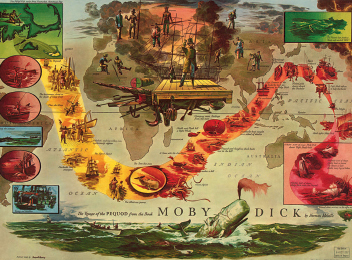The British edition was published as The Whale on October 18, 1851. Melville changed his mind about the title in time for the American edition (shown here), which was published on November 14, 1851, as Moby-Dick; or, The Whale.
A former mariner’s epic tale about Captain Ahab’s obsessive pursuit of a ferocious white whale is revered as one of the great novels in English literature. Yet some of its most enduring qualities may have come from a hike up Monument Mountain with America’s leading symbolic novelist.
Herman Melville (1819–91) had spent eighteen months roaming the oceans as an ordinary seaman aboard the whaling ship Acushnet. His experiences were to find outlet in his greatest novel, which was first published in London in October 1851 as The Whale and a month later in New York as Moby-Dick; or, The Whale.
Melville had gathered an enormous body of research and oral history about whaling, yet as he toiled over his novel, he longed to produce something more profound and original. On August 5, 1850, Melville took a break from his labours to go on an outing with a friend, Oliver Wendell Holmes Sr., and the celebrated author Nathaniel Hawthorne, who had recently published his great allegorical novel, The Scarlet Letter. Together they climbed Monument Mountain in Great Barrington, Massachusetts, in what was for the younger writer Melville a life-altering exchange. Hawthorne’s influence on the scope of The Whale was profound, and Melville dedicates the book to him, ‘in token of my admiration for his genius.’
Melville’s narrator, Ishmael, tells the story of Captain Ahab’s obsessive quest for the white whale that had wrenched off his leg on a previous whaling expedition and left him with a peg leg carved from a whale’s jawbone. As the voyage progresses, Ishmael realises that the voyage is less of a commercial whaling trip and more about Ahab’s revenge. Their ship, the Pequod, encounters many other ships, always ending with an inquiry about the whereabouts of the white whale, Moby-Dick. At the conclusion, the whale ends up destroying the Pequod, and all those aboard, a similar fate to the whaler Essex out of Nantucket, which was sunk by a sperm whale in the Southern Ocean in 1820, of which seven crew members survived thanks only to cannibalism.
Melville had read an account of the Essex written by its first mate, Owen Chase, and was also aware of the story of Mocha Dick, a white sperm whale killed in the late 1830s in waters off the Chilean island of Mocha, which was said to attack ships with premeditated ferocity.
Moby-Dick is both a gripping narrative on the perils of harpooning from a flimsy whaleboat and the tensions that arise from one man’s secretive monomania. Interspersed are essays on whales and whale hunting, and Melville uses many different literary styles and devices, including songs, poetry, stage directions and soliloquies. The book’s many asides are used in the exploration of social status, good and evil, and the existence of God.
Although the book’s opening line – ‘Call me Ishmael’ – would become one of the most famous in literature, the book was not a commercial success in Melville’s lifetime. When he died in 1891, the book had sold 3,200 copies and long been out of print.
The book’s revival began at the centenary of his birth in 1919. E.M. Forster and D.H. Lawrence both became champions of the novel, and it has been reevaluated throughout the twentieth century and steadily gained its place in the canon of great American literary works.
The British edition was published as The Whale on October 18, 1851. Melville changed his mind about the title in time for the American edition (shown here), which was published on November 14, 1851, as Moby-Dick; or, The Whale.

This illustration, showing ‘The Voyage of the Pequod from the Book Moby Dick by Herman Melville’, was one of twelve literary maps produced by the Harris-Seybold Company of Cleveland between 1953 and 1964.